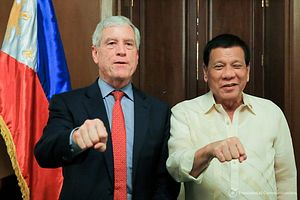This week, Australian warships docked in the Philippines for a goodwill visit as part of one of the largest coordinated task group deployments by Canberra to the region in decades. The interaction put the spotlight on the Australia-Philippine defense relationship as well as Australia’s security role in the region more broadly.
As I noted last week, since September, a fleet of six Royal Australian Navy (RAN) ships along with more than 1,200 Australian Defense Force Personnel have been around the region for Indo-Pacific Endeavor 2017, dubbed the largest coordinated Australian task group deployment since the early 1980s (See: “Australia’s Big Asia Military Deployment Moves to Malaysia”).
Indo-Pacific Endeavor 2017, which lasts till late November, is occurring across Asian states, including Brunei, Cambodia, Micronesia, India, Indonesia, Japan, Malaysia, the Philippines, South Korea, Singapore, Thailand and East Timor. It is being led by Canberra-class amphibious ship HMAS Adelaide, which will be joined at various stages by frigates HMAS Melbourne, HMAS Darwin, HMAS Toowoomba, HMAS Parramatta, and replenishment ship HMAS Sirius.
After the spotlight was on Malaysia last week, this week it shifted to the Philippines. On October 10, the Philippine Navy welcomed two RAN warships in Manila, the HMAS Adelaide and the HMAS Darwin. The ships were there for a goodwill visit that will last until October 15.
The arrival of the vessels comes at an interesting time in the context of Australia-Philippine defense relations. Initially, defense ties, which that had expanded in recent years to include not just exchanges, exercises, and capacity-building, but the conclusion of a visiting forces agreement (VFA) and Canberra’s integration into the U.S.-Philippine Balikatan exercises, had appeared to be quite testy with the emergence of Philippine President Rodrigo Duterte last year (See: “How Significant is the 2017 US-Philippines Balikatan Military Exercise?”).
But day-to-day cooperation had continued and had even accelerated in some cases, particularly since the siege of the southern Philippine city of Marawi by Islamic State-linked militants had exposed the well-known limitations of the Philippine military and underlined its need for help from its regional partners like Australia. Australian officials, including Foreign Minster Julie Bishop and Australian Secret Intelligence Service Director Nick Warner, have been discussing the contours of that counterterrorism assistance (See: “What Will Australia’s New Military Terror Aid to the Philippines Look Like?”).
Though there will be a series of interactions during the goodwill visit by Australian warships this week, the headlines were unsurprisingly dominated by Duterte’s visit on board the HMAS Adelaide on Tuesday afternoon. Duterte was accompanied by other Philippine officials, including Foreign Secretary Alan Peter Cayetano, military chief General Eduardo Ano, and National Security Adviser Hermogenes Esperon Jr.
According to local media outlets, Duterte and the accompanying officials were welcomed by Assistant Defense Attache Gideon Scrimgwour and Australian Ambassador Amanda Gorely, who, in her remarks, underscored the importance of common strategic priorities like ensuring maritime security and maintaining regional stability. They were also given a tour of the ship by the Commander of the Joint Task Group of Indo-Pacific Endeavor, Captain Jonathan Earley.
































